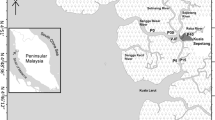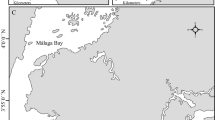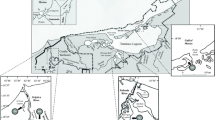Abstract
Plant invasions can fundamentally alter detrital inputs and the structure of detritus-based food webs. We examined the detrital pathways in mangrove food webs in native (Puerto Rican) and introduced (Hawaiian) Rhizophora mangle forests using a dual isotope approach and a mixing model. Based on trophic-level fractionation of 0–1‰ for δ 13C and 2–3‰ for δ 15N, among the invertebrates, only nematodes, oligochaetes, and nereid polychaetes from native mangroves exhibited stable isotopes consistent with a mangrove-derived diet. Certain fauna, in particular tubificid oligochaetes, had δ 13C values consistent with the consumption of mangrove leaves, but they were depleted in 15N, suggesting their primary nitrogen source was low in 15N, and was possibly N2-fixing bacteria. In introduced mangroves, all feeding groups appeared to rely heavily on non-mangrove sources, especially phytoplankton inputs. Mixing model results and discriminant analysis showed clear separation of introduced and native mangrove sites based on differential food source utilization within feeding groups, with stronger and more diverse use of benthic foods observed in native forests. Observed differences between native and invasive mangrove food webs may be due to Hawaiian detritivores being poorly adapted to utilizing the tannin-rich, nitrogen-poor mangrove detritus. In addition, differential utilization of mangrove detritus between native and introduced mangroves may be a consequence of forest age. We postulate that increasing mangrove forest age may promote diversification of bacterial food webs important in N and S cycling. Our results also suggest a potentially important role for sulfur bacteria in supporting the most abundant infaunal consumers, nematodes, in the most mature systems.





Similar content being viewed by others
References
Adam P (2002) Salt marshes in a time of change. Environ Conserv 29:39–61
Allen JA (1998) Mangroves as alien species: the case of Hawaii. Global Ecol Biogeogr Lett 7:61–71
Alongi DM (1987) The influence of mangrove-derived tannins on intertidal meiobenthos in tropical estuaries. Oecologia 71:537–540
Alongi DM (1998) Coastal ecosystem processes. CRC, Boca Raton, FL
Barnard JL (1969) The families and genera of marine gammaridean amphipoda. US Natl Museum Bull 271:1–535
Barnes RD (1980) Invertebrate zoology. W.B. Saunders, Philadelphia, PA
Boto KG, Robertson AI (1990) The relationship between nitrogen fixation and tidal exports of nitrogen in a tropical mangrove system. Est Coast Shelf Sci 19:531–540
Bouillon S, Koedam N, Raman AV, Dehairs F (2002) Primary producers sustaining macro-invertebrate communities in intertidal mangrove forests. Oecologia 130:441–448
Bouillon S, Koedam N, Baeyens W, Satyanarayana B, Dehairs F (2004) Selectivity of subtidal benthic invertebrate communities for local microalgal production in an estuarine mangrove ecosystem during the post-monsoon period. J Sea Res 51:133–144
Brooks JM, et al. (1987) Deep-sea hydrocarbon seep communities: evidence for energy and nutritional carbon sources. Science 238:1138–1142
Bunn SE, Loneragan NR, Kempster MA (1995) Effects of acid washing on stable isotope ratios of C and N in penaeid shrimp and seagrass: implications for food-web studies using multiple stable isotopes. Limnol Oceanogr 40:622–625
Callaway JC, Josselyn MN (1992) The introduction and spread of smooth cordgrass (Spartina alterniflora) in South San Francisco Bay. Estuaries 15:218–226
Carman KR, Fry B (2002) Small-sample methods for δ13C and δ15N analysis of the diets of marsh meiofaunal species using natural-abundance and tracer-addition isotope techniques. Mar Ecol Prog Ser 240:85–92
Cintron G, Lugo AE, Pool DJ, Morris G (1978) Mangroves of arid environments in Puerto Rico and adjacent islands. Biotropica 10:110–121
Crooks JA (2002) Characterizing ecosystem-level consequences of biological invasions: the role of ecosystem engineers. Oikos 97:153–166
Currin CA, Newell SY, Paerl HW (1995) The role of standing dead Spartina alterniflora and benthic microalgae in salt marsh food webs: considerations based on multiple stable isotope analysis. Mar Ecol Prog Ser 121:99–116
Deegan LA, Garritt RH (1997) Evidence for spatial variability in estuarine food webs. Mar Ecol Prog Ser 147:31–47
Dehairs F, Rao RG, Chandra Mohan P, Raman A, Marguillier S, Hellings L (2000) Tracing mangrove carbon in suspended matter and aquatic fauna of the Gautami-Godavari Delta, Bay of Bengal (India). Hydrobiologia 431:225–241
Demopoulos AWJ (2004) Aliens in paradise: a comparative assessment of introduced and native mangrove benthic community composition, food-web structure, and litter-fall production. Ph.D. dissertation, University of Hawaii, Honolulu
DeNiro MJ, Epstein S (1978) Influence of diet on the distribution of carbon isotopes in animals. Geochim Cosmochim Acta 42:495–506
Devaney DM (1982) Kane’ohe : a history of change. Bess Press, Honolulu
Engel AS, Porter ML, Stern LA, Bennett PC (2002) Metabolic and isotopic diversity of chemoautotrophic sulfur-oxidizing bacteria from Lower Kane Cave, Wyoming. J Cave Karst Stud 180–181
Fauchald K, Jumars PA (1979) The diet of worms: a study of polychaete feeding guilds. Oceanogr Mar Biol A Rev 17:193–284
France R (1998) Estimating the assimilation of mangrove detritus by fiddler crabs in Laguna Joyuda, Puerto Rico, using dual stable isotopes. J Trop Ecol 14:413–425
France R, Peters R (1997) Ecosystem differences in trophic enrichment of 13C in aquatic food webs. Can J Fish Aquat Sci/J Can Sci Halieut Aquat 54:1255–1258
Fry B, Ewel KC (2003) Using stable isotopes in mangrove fisheries research—a review and outlook. Isot Environ Health Stud 39:191–196
Fry B, Lutes R, Northam M, Parker PL (1982) A 13C/ 12C comparison of food webs in Caribbean seagrass meadows and coral reefs. Aquat Bot 14:389–398
Fry B, Smith TJ III (2002) Stable isotope studies of red mangroves and filter feeders from the Shark River estuary, Florida. Bull Mar Sci 70:871–890
Fry B, Macko SA, Zieman JC (1987) Review of stable isotopic investigations of food webs in seagrass meadows. In: Durako MJ, Phillips RC, RR Lewis I (eds) Symposium on subtropical–tropical seagrasses of the Southeastern United States. Florida Marine Research Publications, St. Petersburg, FL, pp 189–209
Giere O (1993) Meiobenthology. The microscopic fauna in aquatic sediments. Springer, Berlin
Grosholz ED (2002) Ecological and evolutionary consequences of coastal invasions. Trends Ecol Evol 17:22–27
Hall RO Jr (1995) Use of a stable carbon isotope addition to trace bacterial carbon through a stream food web. J North Am Benthol Soc 14:269–277
Hsieh HL, Chen CP, Chen YG, Yang HH (2002a) Diversity of benthic organic matter flows through polychaetes and crabs in a mangrove estuary: δ13C and δ34S signals. Mar Ecol Prog Ser 227:145–155
Hsieh HL, Kao WY, Chen CP, Liu PJ (2002b) Detrital flows through the feeding pathway of the oyster (Crassostrea gigas) in a tropical shallow lagoon: δ13C signals. Mar Biol 136:677–684
Jones CG, Lawton JH, Shachak M (1994) Organisms as ecosystem engineers. Oikos 69:373–386
Kukert H, Smith CR (1992) Disturbance, colonization and succession in a deep-sea sediment community: artificial-mound experiments. Deep-Sea Res 39:1349–1371
Lee SY (2000) Carbon dynamics of Deep Bay, eastern Pearl River estuary, China. II: trophic relationship based on carbon- and nitrogen-stable isotopes. Mar Ecol Prog Ser 205:1–10
Levin LA, Talley TS (2000) Influences of vegetation and abiotic environmental factors on salt marsh benthos. In: Weinstein MP, Kreeger DA (eds) Concepts and controversies in tidal marsh ecology. Kluwer, Amsterdam
Levin L, Neira C, Grosholz ED (2006) Invasive cordgrass modifies wetland trophic function. Ecology 87:419–432
MacCaughey V (1917) The mangrove in the Hawaiian Islands. Hawaiian Forester Agric 14:361–366
Mahadevan A, Muthukumar G (1980) Aquatic microbiology with reference to tannin degradation. Hydrobiologia 72:73–79
Mann FD, Steinke TD (1989) Biological nitrogen fixation (acetylene reduction) associated with green algal (cyanobacterial) communities in the Beachwood Mangrove Nature Reserve. 1. The effect of environmental factors on acetylene reduction activity. S Afr J Bot/S Afr Tydskr Plantkd 55:438–446
Marguillier S, Velde Gvd, Dehairs F, Hemminga MA, Rajagopal S (1997) Trophic relationships in an interlinked mangrove-seagrass ecosystem as traced by δ13C and δ15N. Mar. Ecol Prog Ser 151:115–121
Marrioti A, Germon JC, Hubert P, Kaiser P, Letollw R, Tardieux A, Tardieux P (1981) Experimental determination of nitrogen kinetic isotope fractionation: some principles; illustration for the denitrification and nitrification processes. Plant Soil 62:413–430
McCutchan JH Jr, Lewis WM Jr, Kendall C, McGrath CC (2003) Variation in trophic shift for stable isotope ratios of carbon, nitrogen, and sulfur. Oikos 102:378–390
Moens T, Luyten C, Middelburg JJ, Herman PMJ, Vincx M (2002) Tracing organic matter sources of estuarine tidal flat nematodes with stable carbon isotopes. Mar Ecol Prog Ser 234:127–137
Montagna PA (1995) Rates of metazoan meiofaunal microbivory: a review. Vie Milieu 45:1–9
Moseman S, Levin LA, Currin C, Fordera C (2004) Colonization, succession, and nutrition of macrobenthic assemblages in a restored wetland at Tijuana Estuary, California. Est Coast Shelf Sci 60:755–770
Neilson MJ, Giddins RL, Richard GN (1986) Effects of tannins on the palatability of mangrove leaves to the tropical sesarminid crab Neosarmatium smithi. Mar Ecol Prog Ser 34:185–186
Neira C, Levin LA, Grosholz ED (2005) Benthic macrofaunal communities of three sites in San Francisco Bay invaded by hybrid Spartina, with comparison to uninvaded habitats. Mar Ecol Prog Ser 292:111–126
Newell RIE, Marshall N, Sasekumar A, Chong VC (1995) Relative importance of benthic microalgae, phytoplankton, and mangroves as sources of nutrition for penaeid prawns and other coastal invertebrates from Malaysia. Mar Biol 123:595–606
Nowell ARM, Jumars PA (1984) Flow environments of aquatic benthos. Annu Rev Ecol Syst 15:303–328
Odum WE, Heald EJ (1975) The detritus-based food web of an estuarine mangrove community. Est Res 265–286
Parsons TR, Sharp JC, Li WKW (1985) The cultivation of marine amphipods and their use as food for young salmonids. J Appl Ichthyol 1:77–84
Peterson BJ, Howarth RW (1987) Sulfur, carbon, and nitrogen isotopes used to trace organic matter flow in the salt-marsh estuaries of Sapelo Island, Georgia. Limnol Oceanogr 32:1195–1213
Peterson B, Howarth RW, Lipschultz F, Ashendorf D (1980) Salt marsh detritus: an alternative interpretation of stable carbon isotope ratios and the fate of Spartina alterniflora. Oikos 34:173–177
Phillips DL, Gregg JW (2003) Source partitioning using stable isotopes: coping with too many sources. Oecologia 136:261–269
Posey MH (1987) The influence of relative mobilities on the composition of benthic communities. Mar Ecol Prog Ser 31:15–22
Posey MH (1988) Community changes associated with the spread of an introduced seagrass, Zostera japonica. Ecology 69:974–983
Posey MH, Wigand C, Stevenson JC (1993) Effects of an introduced aquatic plant, Hydrilla verticillata on benthic communities in the upper Chesapeake Bay. Est Coast Shelf Sci 37:539–555
Posey MH, Alphin T, Powell C (1997) Plant and infaunal communities associated with a created marsh. Estuaries 20:42–47
Post DM (2002) Using stable isotopes to estimate trophic position: models, methods, and assumptions. Ecology 83:703–718
Powers JS, Veldkamp E (2005) Regional variation in soil carbon and δ13C in forests and pastures of northeastern Costa Rica. Biogeochemistry 72:315–336
Rao GS (2002) Impoverished production of meiobenthos of Vasishta Godavari Estuary. Proc Andhra Pradesh Acad Sci 6:63–68
Rao RG, Woitchik AF, Goeyens L, Riet Av, Kazungu J, Dehairs F (1994) Carbon, nitrogen contents and stable carbon isotope abundance in mangrove leaves from an east Aftrican coastal lagoon (Kenya). Aquat Bot 47:175–183
Rice D, Rooth J, Stevenson JC (2000) Colonization and expansion of Phragmites australis in upper Chesapeake Bay tidal marshes. Wetlands 20:280–289
Riera P, Richard P, Gremare A, Blanchard G (1996) Food source of intertidal nematodes in the Bay of Marennes-Oleron (France), as determined by dual stable isotope analysis. Mar Ecol Prog Ser 142:303–309
Robertson AI, Alongi DM, Boto KG (1992) Food chains and carbon fluxes. In: Robertson AI, Alongi DM (eds) Tropical mangrove ecosystems. American Geophysical Union, Washington, DC, pp 293–326
Robinson JJ, Cavanaugh CM (1995) Expression of form I and form II Rubisco in chemoautotrophic symbioses: implications for the interpretation of stable carbon isotopic values. Limnol Oceanogr 40:1496–1502
Ruiz GM, Carlton JT, Grosholz ED, Hines AH (1997) Global invasions of marine and estuarine habitats by non-indigenous species: mechanisms, extent and consequences. Am Zool 37:621–632
Sanders HL (1969) Benthic marine diversity and the stability–time hypothesis. Brookhaven Symp Biol 12:71–81
Sarakinos HC, Johnson ML, Vander Zanden MJ (2002) A synthesis of tissue-preservation effects on carbon and nitrogen stable isotope signatures. Can J Zool/Rev Can de Zool 80:381–387
Sarbu SM, Kane TC, Kinkle BK (1996) A chemoautotrophically based cave ecosystem. Science 272:1953–1955
Sasekumar A (1974) Distribution of macrofauna on a Malayan mangrove shore. J Anim Ecol 43:51–69
Sessegolo GC, Lana PC (1991) Decomposition of Rhizophora mangle, Avicennia schaueriana and Laguncularia racemosa leaves in a mangrove of Paranagua Bay (southeastern Brazil). Bot Mar 34:285–289
Sheridan P (1997) Benthos of adjacent mangrove, seagrass and non-vegetated habitats in Rookery Bay, Florida, USA. Est Coast Shelf Sci 44:455–469
Slim FJ, Hemminga MA, Ochieng C, Jannick NT, Moriniere EC, Velde GV (1997) Leaf-litter removal by the snail Terebralia palustris (Linneaus) and sesarmid crabs in an East African mangrove forest (Gazi Bay, Kenya). J Exp Mar Biol Ecol 215:35–48
Snelgrove PVR, Butman CA (1994) Animal-sediment relationships revisited: cause versus effect. Oceanogr. Mar Biol Annu Rev 32:111–117
Sokal RR, Rohlf FJ (1995) Biometry. WH Freeman and Co., San Francisco, CA
Steele OC, Ewel KC, Goldstein G (1999) The importance of propagule predation in a forest of non-indigenous mangrove trees. Wetlands 19:705–708
Stoner AW, Zimmerman RJ (1988) Food pathways associated with penaid shrimps in a mangrove-fringed estuary. US Fish Bull 86:543–551
Talley TS, Levin LA (2001) Modification of sediments and macrofauna by an invasive marsh plant. Biol Invasions 3:51–68
Thimdee W, Deein G, Sangrungruang C, Matsunaga K (2001) Stable carbon and nitrogen isotopes of mangrove crabs and their food sources in a mangrove-fringed estuary in Thailand. Benthos Res 56:73–80
Twilley RR (1988) Coupling of mangroves to the productivity of estuarine and coastal waters. In: Jansson BO (ed) Coastal offshore ecosystem interactions. Springer, Berlin, pp 155–180
Wainright SC, Weinstein MP, Able KW, Currin CA (2000) Relative importance of benthic microalgae, phytoplankton and the detritus of smooth cordgrass Spartina alterniflora and the common reed Phragmites australis to brackish-marsh food webs. Mar Ecol Prog Ser 200:77–91
Werry J, Lee SY (2005) Grapsid crabs mediate link between mangrove litter production and estuarine planktonic food chains. Mar Ecol Prog Ser 293:165–176
Whitcraft C, Levin L (2007) Regulation of benthic algal and animal communities by salt marsh plants: impact of shading. Ecology 88:904–917
Zhou H (2001) Effects of leaf litter addition on meiofaunal colonization of azoic sediments in a subtropical mangrove in Hong Kong. J Exp Mar Biol Ecol 256:99–121
Acknowledgments
We thank the many people who have assisted with the field collections, infaunal sorting, and sample analyses, especially the JBNERR Staff, C. Burgos, E. Quiñones, C. Mojica, P. Robles, L. Crawford, A. Thurber, A. Glover, A. Hannides, G. Demopoulos, T. Rust, and J. Tanimoto. Also, the following people assisted with animal identifications: I. Altamira, J. Bailey-Brock, C. Erseus, A. Fukunaga, S. Godwin, K. Longenecker. Grant support was provided by a Hawaii Sea Grant (NA 86RG0041) to C. R. S. and A. D., and from a NOAA/NERR fellowship to A. D. This is contribution no. 7118 from the School of Ocean and Earth Science, the University of Hawaii at Manoa.
Author information
Authors and Affiliations
Corresponding author
Additional information
Communicated by Tim Seastedt.
Electronic supplementary material
Below is the link to the electronic supplementary material.
Rights and permissions
About this article
Cite this article
Demopoulos, A.W.J., Fry, B. & Smith, C.R. Food web structure in exotic and native mangroves: a Hawaii–Puerto Rico comparison. Oecologia 153, 675–686 (2007). https://doi.org/10.1007/s00442-007-0751-x
Received:
Accepted:
Published:
Issue Date:
DOI: https://doi.org/10.1007/s00442-007-0751-x




